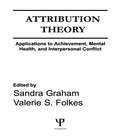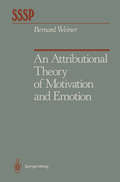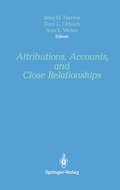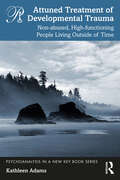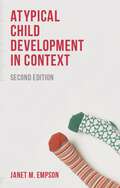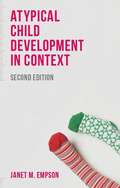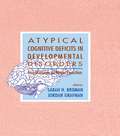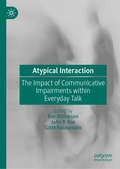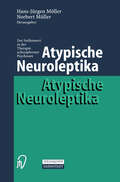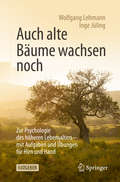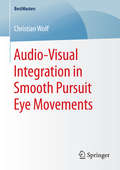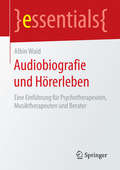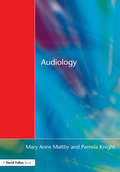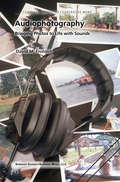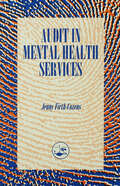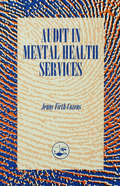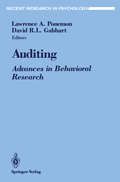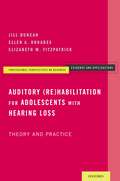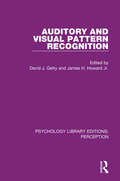- Table View
- List View
Attribution Theory: Applications to Achievement, Mental Health, and Interpersonal Conflict
by Sandra Graham Valerie S. FolkesThis unusual volume begins with a historical overview of the growth of attribution theory, setting the stage for the three broad domains of application that are addressed in the remainder of the book. These include applications to: achievement strivings in the classroom and the sports domain; issues of mental health such as analyses of stress and coping and interpretations of psychotherapy; and personal and business conflict such as buyer- seller disagreement, marital discord, dissension in the workplace, and international strife. Because the chapters in Attribution Theory are more research-based than practice- oriented, this book will be of great interest and value to an audience of applied psychologists.
An Attributional Theory of Motivation and Emotion (Springer Series in Social Psychology)
by Bernard WeinerFor a long time I have had the gnawing desire to convey the broad motivational sig nificance of the attributional conception that I have espoused and to present fully the argument that this framework has earned a rightful place alongside other leading theories of motivation. Furthermore, recent investigations have yielded insights into the attributional determinants of affect, thus providing the impetus to embark upon a detailed discussion of emotion and to elucidate the relation between emotion and motivation from an attributional perspective. The presentation of a unified theory of motivation and emotion is the goal of this book. My more specific aims in the chapters to follow are to: 1) Outline the basic princi ples that I believe characterize an adequate theory of motivation; 2) Convey what I perceive to be the conceptual contributions of the perspective advocated by my col leagues and me; 3) Summarize the empirical relations, reach some definitive con clusions, and point out the more equivocal empirical associations based on hypotheses derived from our particular attribution theory; and 4) Clarify questions that have been raised about this conception and provide new material for still further scrutiny. In so doing, the building blocks (if any) laid down by the attributional con ception will be readily identified and unknown juries of present and future peers can then better determine the value of this scientific product.
Attributions, Accounts, and Close Relationships
by Ann L. Weber Terri L. Orbuch John H. HarveyATTRIBUTIONS, ACCOUNTS AND CLOSE RELATIONSHPIS documents attributional and accounts approaches to the study of close relationships. Issues of focus include communication pro- blems in marriage and their relationship with causal attri- butions; marital violence and its relationship with early learning experience; ego-defensive attribution and excuse- making in couples and with respect to medical problems; and attributions about transitions in relationships.
Attuned Treatment of Developmental Trauma: Non-abused, High-functioning People Living Outside of Time (Psychoanalysis in a New Key Book Series)
by Kathleen AdamsThis book takes a painstaking look at developmental trauma as it manifests in group, individual, and combined psychotherapies, tracking the growth of non-abused individuals who have courageously addressed overwhelming childhood experiences to make sense of the chaos in their lives. The cumulative impact of repetitive stress, fear, and shame in childhood wreaks havoc on the developing brain, resulting in a life-long vulnerability to anxiety, despair, and dissociative moments that are often described as developmental trauma. Adverse childhood experiences are often overlooked by therapists. This book focuses specifically on the profound suffering of high-functioning private-practice patients who manifest developmental trauma from chronic shock, shame, and neglect. Adams offers a synthesis of diverse theoretical worlds in her study of adaptations to cumulative trauma, namely, relational psychoanalysis, the British school of object relations, trauma theory, neuroscience and interpersonal neurobiology, developmental psychopathology, and attachment theory. Using richly detailed clinical material, this book provides invaluably clear examples to illustrate the effects of disorganized states in infancy, making it essential reading for psychoanalysts, psychotherapists and clinical psychologists working with traumatized patients.
Attuned Treatment of Developmental Trauma: Non-abused, High-functioning People Living Outside of Time (Psychoanalysis in a New Key Book Series)
by Kathleen AdamsThis book takes a painstaking look at developmental trauma as it manifests in group, individual, and combined psychotherapies, tracking the growth of non-abused individuals who have courageously addressed overwhelming childhood experiences to make sense of the chaos in their lives. The cumulative impact of repetitive stress, fear, and shame in childhood wreaks havoc on the developing brain, resulting in a life-long vulnerability to anxiety, despair, and dissociative moments that are often described as developmental trauma. Adverse childhood experiences are often overlooked by therapists. This book focuses specifically on the profound suffering of high-functioning private-practice patients who manifest developmental trauma from chronic shock, shame, and neglect. Adams offers a synthesis of diverse theoretical worlds in her study of adaptations to cumulative trauma, namely, relational psychoanalysis, the British school of object relations, trauma theory, neuroscience and interpersonal neurobiology, developmental psychopathology, and attachment theory. Using richly detailed clinical material, this book provides invaluably clear examples to illustrate the effects of disorganized states in infancy, making it essential reading for psychoanalysts, psychotherapists and clinical psychologists working with traumatized patients.
Atypical Antipsychotics (Milestones in Drug Therapy)
by Bart A. Ellenbroek Alexander R. CoolsThe introduction of chlorpromazine in 1953, and haloperidol in 1958, into clinical practice dramatically altered the therapy of schizophrenic patients. Although representing by no means a cure for this severe psychiatric ill ness, it allowed, for the first time, to adequately control the severe hallu cinations and delusional beliefs which prevent these patients from leading a more or less independent life. Indeed these antipsychotics (and the many congeners that were to follow) significantly reduced the number ofchronic schizophrenic inpatients in psychiatric clinics all over the world. However soon after their introduction it became clear that, like all other available drugs, antipsychotics were by no means miracle drugs. In fact, two major problems appeared. First, the antipsychotics had very little effect on the so-called negative or defect symptoms, like social isolation, apathy and anhedonia, and secondly virtually all antipsychotics produced a number of side-effects, of which the neurological (often called extra pyramidal) side-effects were the most troublesome. Especially the tardive dyskinesia, which occurred in about 15 to 20% of the patients after pro longed treatment, represented a major problem in the treatment of schizo phrenic patients.
Atypical Child Development in Context
by Janet EmpsonHave you ever considered what atypical development looks like in practice? Or how it occurs? Would you like to know which children are most at risk and why? In this new and fully updated edition, Janet M. Empson explores what is 'normal' and what is 'atypical' or 'unusual' in children's development. Combining key research with insightful case studies and examples, she examines the processes, circumstances, and conditions associated with developing atypically. This is invaluable reading for both students and professionals involved in child development.
Atypical Child Development in Context (PDF)
by Janet EmpsonThe book considers the important issue of what is 'normal' and what is 'atypical' in child development. It examines the main processes involved in developing atypically, as well as the circumstances and conditions associated with it. The second edition is fully updated and features new research, case studies, real-life examples and figures.
Atypical Cognitive Deficits in Developmental Disorders: Implications for Brain Function
by Sarah H. Broman Jordan GrafmanThis volume is based on a conference held to examine what is known about cognitive behaviors and brain structure and function in three syndromes and to evaluate the usefulness of such models. The goal of this endeavor is to add to the knowledge base of cognitive neuroscience within a developmental framework. Most of what is known about the neurological basis of cognitive function in humans has been learned from studies of central nervous system trauma or disease in adults. Certain neurodevelopmental disorders affect the central nervous system in unique ways by producing specific as opposed to generalized cognitive deficit. Studies of these disorders using neurobiological and behavioral techniques can yield new insights into the localization of cognitive function and the developmental course of atypical cognitive profiles. The focus of this book is a discussion of the multidisciplinary research findings from studies of autism, and Williams and Turner syndromes. The approaches, methods, techniques, and findings reported are at the cutting edge of neuroscience research on complex behavior patterns and their neural substrates. Each disorder is accompanied by some degree of general cognitive impairment or mental retardation. Of greater interest are the atypical deficits in which a cognitive function is spared, such as language in Williams syndrome, or is disproportionately depressed as are spatial discrimination skills and visual-motor coordination in Turner syndrome. Drastically reduced or seemingly absent language capabilities and little interaction with other people characterize the core autism syndrome. A comprehensive and critical discussion of appropriate statistical techniques is made vivid by examples given from studies of small groups or single subjects in neurolinguistics and related fields.
Atypical Cognitive Deficits in Developmental Disorders: Implications for Brain Function
by Sarah H. Broman Jordan GrafmanThis volume is based on a conference held to examine what is known about cognitive behaviors and brain structure and function in three syndromes and to evaluate the usefulness of such models. The goal of this endeavor is to add to the knowledge base of cognitive neuroscience within a developmental framework. Most of what is known about the neurological basis of cognitive function in humans has been learned from studies of central nervous system trauma or disease in adults. Certain neurodevelopmental disorders affect the central nervous system in unique ways by producing specific as opposed to generalized cognitive deficit. Studies of these disorders using neurobiological and behavioral techniques can yield new insights into the localization of cognitive function and the developmental course of atypical cognitive profiles. The focus of this book is a discussion of the multidisciplinary research findings from studies of autism, and Williams and Turner syndromes. The approaches, methods, techniques, and findings reported are at the cutting edge of neuroscience research on complex behavior patterns and their neural substrates. Each disorder is accompanied by some degree of general cognitive impairment or mental retardation. Of greater interest are the atypical deficits in which a cognitive function is spared, such as language in Williams syndrome, or is disproportionately depressed as are spatial discrimination skills and visual-motor coordination in Turner syndrome. Drastically reduced or seemingly absent language capabilities and little interaction with other people characterize the core autism syndrome. A comprehensive and critical discussion of appropriate statistical techniques is made vivid by examples given from studies of small groups or single subjects in neurolinguistics and related fields.
Atypical Interaction: The Impact of Communicative Impairments within Everyday Talk
by Ray Wilkinson John P. Rae Gitte RasmussenAtypical Interaction presents a state-of-the-art overview of research which uses conversation analysis to explore how communicative impairments impact on conversation and other forms of talk and social interaction. Although the majority of people use spoken language unproblematically in social interaction, many individuals have an atypical capacity for communication. The first collection of its kind, this book examines a wide range of conditions where the communication of children or adults is atypical, including autism spectrum disorder, dementia, stammering, hearing impairment, schizophrenia, dysarthria and aphasia. By analyzing recordings of real-life interactions, the collection highlights not only the communication difficulties and challenges faced by atypical communicators and their interlocutors in everyday life, but also the competences and often novel forms of communication displayed. With fourteen empirical chapters from leading scholars in the field and an introductory chapter which provides a background to conversation analysis and its application to the study of atypical interactions, the collection will be an invaluable resource for students, practitioners such as speech and language therapists, and researchers with an interest in human communication, communication diversity and disorder.
Atypische Neuroleptika: Der Stellenwert in der Therapie schizophrener Psychosen
by Hans-Jürgen Möller Norbert MüllerAtypische Neuroleptika: Der Stellenwert in der Therapie schizophrener Psychosen
by Hans-Jürgen Möller Norbert MüllerAuch alte Bäume wachsen noch: Zur Psychologie des höheren Lebensalters - mit Aufgaben und Übungen für Hirn und Hand
by Wolfgang Lehmann Inge JülingDieses Buch hilft Ihnen dabei, mit zunehmendem Alter geistig leistungsfähig zu bleiben, um weiterhin selbstbestimmt zu leben. Denn: Egal, wie alt ein Baum aussieht und egal, wie alt er tatsächlich ist, er kann immer noch aus seinem alten Holz neu austreiben. Genauso hat es jeder auch im höheren Lebensalter selbst in der Hand, Neues zu lernen und so zu trainieren, dass die geistigen Reserven möglichst lange erhalten und genutzt werden können – wollen Sie das? Was wir nicht benutzen, verkümmert. Wenn Sie bereit sind, mit Hirn und Hand aktiv zu sein und durchzuhalten, können Sie Ihre geistige Leistungsfähigkeit mit Hilfe dieses Buches stabilisieren und vielleicht teilweise sogar steigern. Zielgruppen: Alle, die ihre geistige Leistungsfähigkeit im höheren Lebensalter erhalten oder sogar verbessern möchtenAlle, die altersbedingten geistigen Abbauerscheinungen (Demenz) präventiv vorbeugen wollen und Spaß und Freude an geistigen und feinmotorischen Herausforderungen habenAlle, die sich über entwicklungspsychologische Besonderheiten des älteren Menschen informieren oder die privat oder beruflich ältere Menschen / Seniorengruppen betreuen, beschäftigen und fördern möchten Zu den Autoren: Prof. Dr. Wolfgang Lehmann ist Diplompsychologe und externer Mitarbeiter an der Otto-von-Guericke-Universität Magdeburg am Institut für Psychologie. Dr. Inge Jüling ist Diplompsychologin und war als Schulpsychologin tätig. Die Autoren wissen, wovon sie reden: Sie haben jahrelange Erfahrungen mit Senioren, die an Psychologie-Lehrveranstaltungen im Rahmen des Seniorenstudiums "Studieren ab 50" teilnehmen. Das aktive Trainieren hat sich für die Teilnehmer gelohnt, denn sie konnten sich in einigen kognitiven Funktionen sogar verbessern und hatten noch Spaß dabei, Aufgaben zu lösen und Neues zu lernen.
Audio-Visual Integration in Smooth Pursuit Eye Movements (BestMasters)
by Christian WolfChristian Wolf shows that even with unreliable visual information, no auditory motion is integrated to guide smooth pursuit eye movements. This suggests that smooth pursuit eye movements are solely driven by visual motion information and motion information from other senses is disregarded.
Audiobiografie und Hörerleben: Eine Einführung für Psychotherapeuten, Musiktherapeuten und Berater (essentials)
by Albin WaidIn diesem essential lernen Sie die Grundlagen einer Psychologie des Hörens kennen. Dabei erfahren Sie, wie sich die Wahrnehmung von Musik und Klang in Alltag und Biografie beschreiben und für Therapie und Beratung als Ressource nutzbar machen lässt. Von den frühesten audiobiografischen Erfahrungen bis hin zur Vielfalt des Hörens im Erwachsenenalter beschreibt der Autor in ‚Audiobiografie und Hörerleben‘ wichtige Stadien der Entwicklung des Hörens und regt Sie zugleich dazu an, die eigene Audiobiografie zu reflektieren sowie die Bedeutung des Hörens für den Menschen in Alltag und Biografie besser zu verstehen.
Audiology: An Introduction for Teachers & Other Professionals
by Pamela Knight Mary Anne MaltbyThis book is an introduction to audiology for those who have little or no knowledge of the subject. It introduces basic aspects of audiology in a clear and accessible way. This initial knowledge is then developed to a depth which allows the reader to access more specialised journals and textbooks.
Audiology: An Introduction for Teachers & Other Professionals
by Pamela Knight Mary Anne MaltbyThis book is an introduction to audiology for those who have little or no knowledge of the subject. It introduces basic aspects of audiology in a clear and accessible way. This initial knowledge is then developed to a depth which allows the reader to access more specialised journals and textbooks.
Audiophotography: Bringing Photos to Life with Sounds (Computer Supported Cooperative Work #3)
by David M. FrohlichIf you read the history of any new communication medium such as the cinema, television or radio, it always happens to be bound up with advances in some underlying technology. For example, cinema was born out of the rapid projection of a series of still images on a celluloid film strip. The difficulty of synchronizing sound recordings with the resulting moving images led to about 30 years of silent films - until such time as the technical problems were solved. In between the inventions, media seem to grow and develop at a slower pace, as content producers and consumers experiment with the most satisfactory and stimulating ways of communicating with each other. In the same example, silent film-makers eventually found ways of adding dialogue through scene titles and having music played during the projection of their films. This book is about the next chapter in the history of photography, which is emerging from a relatively stable period into a chaos of new inventions. Photography as we know it is at the same point as the silent films of 1926. The transition from analog to digital photography is spawning many new ways of taking, manipulating and sharing photographs. It is also bringing photography and videography closer together by unifying sound, still and moving images in the same digital medium.
Audit In The Mental Health Service
by Firth-Cozens JennyAt last, a book to take practitioners in the mental health field through the various steps involved in successful clinical audit. This book, including its team and individual exercises, is designed to help select topics for audit, to understand the methods most appropriate, to set standards, understand the significance of outcomes, and to bring about changes as a result. It is a practical guide to the analysis of health care, both for those working within a professional group, and for those in multidisciplinary teams. The book will be invaluable for all mental health professionals - psychiatrists, psychologists, nurses, occupational therapists, psychiatric social workers - and purchaser or provider managers interested in clinical audit and the measurement of quality more generally.
Audit In The Mental Health Service
by Firth-Cozens JennyAt last, a book to take practitioners in the mental health field through the various steps involved in successful clinical audit. This book, including its team and individual exercises, is designed to help select topics for audit, to understand the methods most appropriate, to set standards, understand the significance of outcomes, and to bring about changes as a result. It is a practical guide to the analysis of health care, both for those working within a professional group, and for those in multidisciplinary teams. The book will be invaluable for all mental health professionals - psychiatrists, psychologists, nurses, occupational therapists, psychiatric social workers - and purchaser or provider managers interested in clinical audit and the measurement of quality more generally.
Auditing: Advances in Behavioral Research (Recent Research in Psychology)
by David R. L.Gabhart Lawrence A. PonemonThis book has been prepared for those readers who want to maintain their knowledge of current developments in the field of behavioral research as applied to auditing. The articles and papers presented in this volume were selected because they will contribute to the knowledge and advancement of not only the individual researcher or educator, but also of the profession. It is our belief that if research endeavors may be viewed as having stages of life, then the field of behavioral research in auditing is in its genesis. Almost twenty years ago, in speaking of the state of the art of psychology, William Hays expressed a most·appropriate thought: Experimental evidence is accumulating at a rapid rate in psychology, and efforts at constructing psychological theories with mathematical deductive power are constantly being made. However, it seems safe to say that it will be sometime before there are psychological laws and theories on a par with those of physics. The absence of a general theory does not imply that those relations are missing or unhpportant in psychology; the discovery and specification of relations is the process by which those theories are built. (Hays, 1973, p. 40.) In the first chapter, "Experimental Research and the Distinctive Features of Accounting Settings," Robert Libby presents an encompassing and knowledgeable summary of the changes that have taken place during the last decade in human information processing research in accounting and experimental economics as it relates to those issues.
Auditory: Theory and Practice (Professional Perspectives On Deafness: Evidence and Applications)
by Jill Duncan Ellen A. Rhoades Elizabeth M. FitzpatrickThere is a growing realization that many adolescents with hearing loss require special attention. Despite the benefits of early diagnosis, early amplification, and early intervention, some adolescents with hearing loss do not achieve age-equivalent developmental milestones. The purpose of this book is to assist auditory (re)habilitation practitioners in mitigating the negative effects of hearing loss on communicative, socio-emotional, and academic performance of adolescents who rely on auditory-based spoken language to communicate. It is essential that adolescents whose parents chose auditory-based spoken language receive systematic, consistent, well-planned, appropriate auditory (re)habilitation. In Auditory (Re)Habilitation for Adolescents with Hearing Loss, Jill Duncan, Ellen A. Rhoades, and Elizabeth Fitzpatrick provide practitioners with key milestones considered fundamental to understanding adolescents with hearing loss as well as a pedagogical foundation and general intervention strategies for both planning and direct face-to-face (re)habilitation with adolescents. The authors summarize important issues related to the spoken language development of adolescents, focus on aspects of communication that are functionally relevant to adolescents with hearing loss, and provide strategies for facilitating auditory-based spoken communication skills. They conclude with a discussion of factors influencing auditory (re)habilitation, both in service delivery and outcomes, and provide the application of theory to practice through a demonstration of case studies.
Auditory and Visual Pattern Recognition (Psychology Library Editions: Perception #10)
by David J. Getty James H. HowardThe systematic scientific investigation of human perception began over 130 years ago, yet relatively little is known about how we identify complex patterns. A major reason for this is that historically, most perceptual research focused on the more basic processes involved in the detection and discrimination of simple stimuli. This work progressed in a connectionist fashion, attempting to clarify fundamental mechanisms in depth before addressing the more complex problems of pattern recognition and classification. This extensive and impressive research effort built a firm basis from which to speculate about these issues. What seemed lacking, however, was an overall characterization of the recognition problem – a broad theoretical structure to direct future research in this area. Consequently, our primary objective in this volume, originally published in 1981, was not only to review existing contributions to our understanding of classification and recognition, but to project fruitful areas and directions for future research as well. The book covers four areas: complex visual patterns; complex auditory patterns; multi-dimensional perceptual spaces; theoretical pattern recognition.
Auditory and Visual Pattern Recognition (Psychology Library Editions: Perception #10)
by James H. Howard David J. GettyThe systematic scientific investigation of human perception began over 130 years ago, yet relatively little is known about how we identify complex patterns. A major reason for this is that historically, most perceptual research focused on the more basic processes involved in the detection and discrimination of simple stimuli. This work progressed in a connectionist fashion, attempting to clarify fundamental mechanisms in depth before addressing the more complex problems of pattern recognition and classification. This extensive and impressive research effort built a firm basis from which to speculate about these issues. What seemed lacking, however, was an overall characterization of the recognition problem – a broad theoretical structure to direct future research in this area. Consequently, our primary objective in this volume, originally published in 1981, was not only to review existing contributions to our understanding of classification and recognition, but to project fruitful areas and directions for future research as well. The book covers four areas: complex visual patterns; complex auditory patterns; multi-dimensional perceptual spaces; theoretical pattern recognition.
